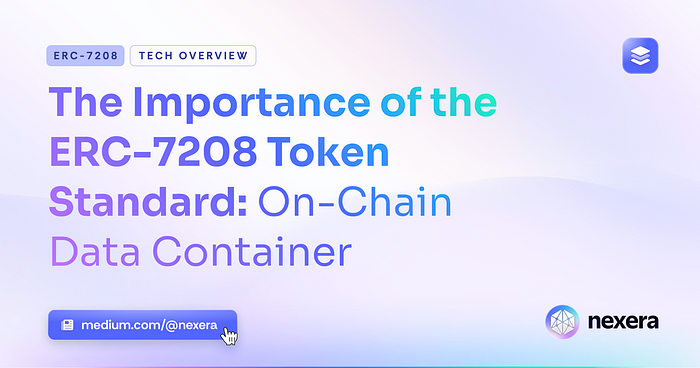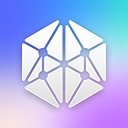
Since 2018, Nexera has supported the development of an expansive network for web3 solutions that bridge TradFi and DeFi in more sustainable ways than what exists today. All of this is enabled by its introduction of ERC-7208.
This new token standard is what ties the ecosystem together and forms the basis of projects such as Brillion and many others. Soon, it will also have a unique impact on the advancement of many emerging use cases for web3, starting with the tokenization of real world assets (RWAs).
Let’s take a look at what ERC-7208 means for Nexera today and why it’s necessary for the future of onchain finance.
What is ERC-7208?
To understand ERC-7208 we first need to understand token standards. These are the fundamental groundwork for some of the most important developments in web3 because they define new possibilities for what can be built on a specific network.
There are entire asset categories that were created by a token standard. NFTs, for example, are based on the ERC-721 standard for non-fungible tokens and the ERC-1155 standard that extends it into supporting multiple tokens types. We’ve also seen the introduction of new features to existing applications like web3 wallets that are only possible thanks to the implementation of a token standard like ERC-4337 for account abstractions.
At their core, token standards are a set of predefined rules for how millions of people will make use of networks like Ethereum. We can think of them as widely adopted templates for smart contracts that are used for specific purposes and applications.
When these templates are approved and used by the community, they create a general agreement on how certain applications work and communicate between each other. This agreement is what ensures that they can be used and built upon freely by any participant in the network.
A Meta Token Standard
ERC-7208 is a new token standard. More importantly, it’s a unique kind of token standard that can add a new layer of functionality to existing ones and the web3 applications that make use of them. We can think of it as a token standard for other standards, or a meta token standard. Another word for it could be an “onchain adapter” because it is able to adapt an ERC standard to another one.
To understand this we’ll have to look at what ERC-7208 proposes and its implications for web3:
The main breakthrough in ERC-7208 is its approach to onchain data management. Typically, smart contracts store information about an asset in the same place where they store the instructions that describe what can be done with it. When ERC-7208 is used in a project, however, it creates a separation between where data is stored and the logic that is applied to that data.
ERC-7208 does this by creating Onchain Data Containers (ODCs) that can be used by other smart contracts to store and retrieve information about a particular asset — or more formally, its Properties. What’s even more interesting is that these Properties can be modified by designated smart contracts known as Property Managers with Restrictions that limit their capabilities.
It sounds simple, but the subtle distinction between the current approach to onchain data management and ERC-7208 has important implications. What ODCs, Properties, and Restrictions introduce is a new way for web3 applications to manage data, and by extension, the assets that are represented by it.
Assets that make use of ERC-7208 are:
- Composable: They can be split and combined with other assets.
- Mutable: They can be changed or updated over time.
- Extensible: They can be expanded upon by other smart contracts.
We can think of them as self-contained assets that live onchain but exist independently from any particular smart contract or application. For example, right now an NFT exists as part of a larger smart contract that also determines how each NFT will behave. If the NFT were a self-contained asset instead, it would exist outside of that smart contract and as its own object on the blockchain that simply stores all the information that’s relevant to the NFT.
This approach has many advantages, starting with the fact that it makes these assets interoperable with any token standard. ERC-7208 assets can be a resource they can all use, edit, or combine freely.
Why Do We Need a New Token Standard?
Right now there is no token standard that can be used effectively and across the board to represent complex assets. The main reason is the limitations that exist when storage and logic are bundled together, which is the case in current standards.
Nonetheless, there are critical web3 use cases that need more sophisticated ways to represent assets, and therefore, more flexible ways to store data. A prime example is seen in the market for the tokenization of real world assets which grew 286% in Q1 2024.
Projects have decided to use oracle services and external providers to solve this issue, which affects user experience and creates potential security issues. In some cases, they’ve even developed custom token standards or enhanced existing ones in ways that are only suitable for niche use cases and are not interoperable. This creates further fragmentation in the space.
With an implementation of ERC-7208 none of this would be necessary. Although its potential use cases are infinite, here are a few specific ones that would unlock important opportunities for web3 projects:
RWAs
The flexibility that’s introduced by ERC-7208 is especially handy when we need to represent real world assets on chain. This is because, by definition, they have to be able to respond to all the kinds of situational factors that affect them in the real world.
Let’s imagine a tokenized real estate property that is purchased for $100,000 USD. If the owner wants to fractionalize the property — that is, splitting its ownership into 100,000 different $1 deeds, for example — they would’ve needed to code this at the moment of the initial tokenization. With ERC-7208, the asset can be “wrapped” at any time with a smart contract that handles the fractionalization.
This and many other features around RWAs will be available on Evergon Labs (previously known as Nexera Finance).
Smart Wallets
Having ODCs as specified in ERC-7208 means that wallets can now use them to hold assets like wBTC or ETH and then implement rules for how to access these assets that are local to the wallet itself. This comes in very handy for all sorts of security reasons.
Let’s imagine a situation where a user has lost access to their wallet. What usually happens is that their assets would become irretrievable. However, a wallet using ERC-7208 would’ve allowed the user to set a rule where they can recover their assets under certain conditions such as logging in from a trusted setup, for example.
A socialized version of this recovery method will be available on the Brillion wallet.
AI Agents
Data stored in ODCs is also actionable to AI agents. This means that an asset that’s represented by ERC-7208 can be connected to a machine learning algorithm and be managed by it.
Let’s imagine a DeFi trader who is concerned about impermanent loss on a particular liquidity pool they are participating in. Today, they would have to actively look at price changes and manually take their assets out of the liquidity pool. ERC-7208 would let the trader set up an AI Agent that takes care of this for them.
Nuklai is an AI project that is exploring similar solutions that make use of ERC-7208.
The Current State of the EIP for ERC-7208
ERC-7208 is already used by a growing number of projects who are building in the Nexera ecosystem. These talented development teams are working on innovative solutions that explore the infinite use cases that can come out of better onchain data management. Moreover, they are supporting the adoption of ERC-7208 by the rest of the Ethereum community.
Currently, the EIP for ERC-7208 is in its draft phase and has received great feedback. This means that it will soon be submitted for approval after any necessary technical improvements are made. Once approved by an EIP Editor, ERC-7208 would be officially implemented at an application level on the Ethereum network.
If you’re a developer who’s interested in the advantages of ERC-7208, you can help this process by reviewing the official EIP and participating in the discussion. Even if you’re not technical, the Nexera DAO has started important initiatives to ensure that its benefits are widespread across web3.
About Nexera
Nexera is empowering the future of finance with cutting-edge open-source innovation. Nexera infrastructure seamlessly incorporates blockchain technology, facilitating on-chain and off-chain operations for simplified digital, financial, and real-world asset management.
Nexera is focused on nurturing the broader ecosystem and DAO and enhancing the utility of the $NXRA token. It is committed to promoting community growth and driving innovation in the digital asset space, including the growth and development of current and future key ecosystem partners.
Ask us any questions about ERC-7208 on the dedicated Telegram channel or the Nexera social and community channels.
